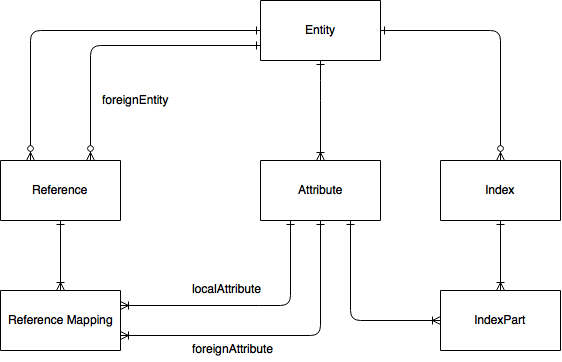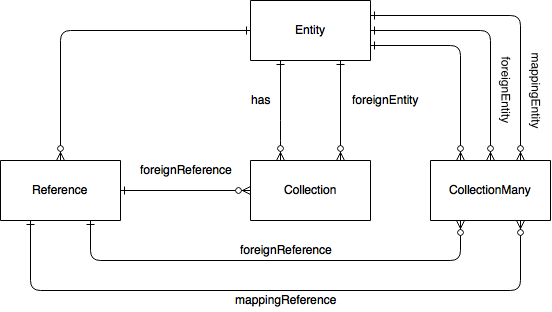The datamodel
Both Generator and Plugin interface will get the Entity object passed, that is subject to generation. The Entity
class represents a generated class respectively a table in the database. It has 1..n Attributes which in term
represent a member in the generated entity as well as a column in the corresponding table. An Index consists
of 1..n IndexPart which in term reference an attribute. An attribute/column can be part of serveral indexes.
A reference (foreign key) always refers a foreign entity and has 1..n ReferenceMapping. A referenceMapping
maps a local attribute (in the entity in which it is defined) and a foreign Attribute in the foreign entity.
The Entity has methods like
- Entity->getAttributeList()
- Entity->getReferenceList()
- Entity->getIndexList()

A little bit more complex are Collections and Many 2 Many Collections. An entity can have 0..n collections.
A collection always refers to a foreign entity and a foreign reference. So for example if you have the CartItem
object which references a Cart. (CartItem has a foreign key/ references to the cart object) A collection allows
you to collect all CartItems which refer the the given Cart. Therefore a collection needs to know the foreign entity
and the foreign reference.
An entity can also 0..n Collection Many. As an example you find in the tests the relationship between students
and exams. A student can participate in 0..n exams. and every exam can have 0..n students participating. This
is typically realized with a mapping table. Therefore a collection Many has a foreignEntity and a mapping entity.
Furthermore to foreignReference is the reference between the mapping table and the foreign entity. The mappingReference
is the reference between the entity and the mapping entity.
Also here you will find all needed methods to access these objects.
- Entity->getCollectionList()
- Entity->getCollectionManyList()
- Collection->getForeignEntity()
- Collection->getForeignReference()
- CollectionMany->getMappingEntity()
